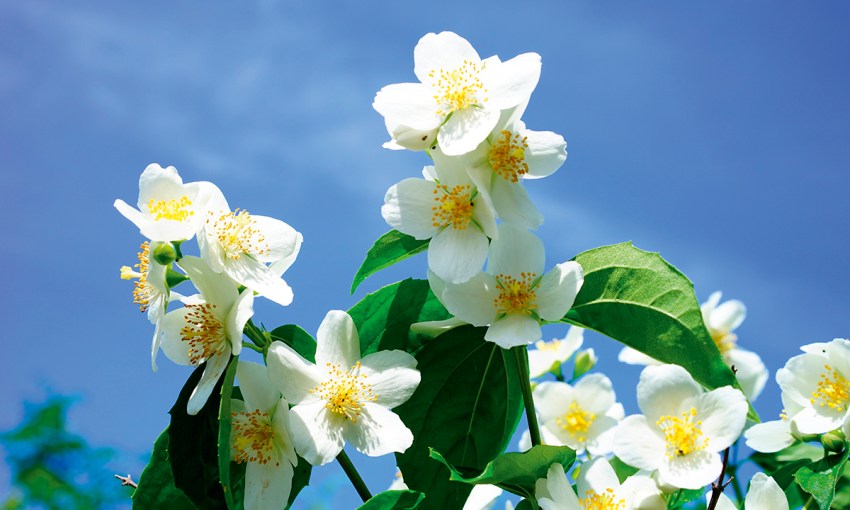With a mass of white flowers and an intoxicating perfume, the mock orange is a treat for the senses in any garden.
In the garden: Scented stunner
One of the most beautiful plants that nature has given the home gardener is the original mock orange or Philadelphus coronarius. Described by English herbalist John Gerard, way back in Shakespeare’s day, as “shrub with flowers of very rich, persuasive, almost cloying scent, troubling and molesting the head if brought indoors”.
The name philadelphus is derived from the Greek phyllos and delphos meaning brotherly love and is said to be the name the Greeks used in honour of an Egyptian King. The philadelphus genus consists of 60-plus varieties and many of them, if available, will grow successfully in our SA gardens. The one that is commonly called mock orange has been gracing our gardens for many generations; I can recall my mother cutting large sprays of spectacular white blooms and giving them to friends or making arrangements for various indoor areas. It would have to be one of the best small, highly-perfumed plants that one could grow in the garden. But not all philadelphus have the strong orange perfume.
They are deciduous plants that can be grown in full sun or partially shaded, well-draining spots in the garden, protected from our menacing afternoon summer sun. Philadelphus are generally undemanding plants, I would describe them as hardy and, to a large degree, waterwise. I can’t ever remember seeing critters having a nibble or fungi attacking the plants; they are considered almost pest free, if well set up in the garden from day one.
They prefer a planting hole that is as deep as it is wide, the backfill mixed with mature, compost or Seamungus, or dynamic lifter mixed in with the soil.
Over the years there have been many hybrids bred and released onto the retail market and one of the superstars is the French-bred Philadelphus viginalis. Victor Lemoine, a French nurseryman who began to hybridise the genus as the different species in 1883, continued releasing new cultivars until 1920. Described by growers as a vigorous, deciduous shrub with oval, green foliage and fragrant clusters of pretty, double white flowers, it is a very frost hardy plant, just a perfect choice for a hedge or even a fence line. P. Virginalis also has the fragrance of orange blossom and is very attractive to bees, butterflies and birds.
Philadelphus flower during the months of October, November and December, depending on the season, but I have also had the odd spot flowering later into summer.
It is best to prune them annually after flowering, by pruning back the flowering shoot to a point where a promising new one is developing, as they will flower on this wood next season. Add in a good tidy up every few years, simply by removing around a quarter of all stems to ground level. A warning though, a harsh pruning can set flowering back, sometimes for years.
Philadelphus can easily be propagated by taking “softwood” cuttings early in summer or autumn, or “hardwood cuttings” in winter. Another sure-fire way of propagating them is to carefully take a “heel” cutting, which is a semi-hardwood cutting that often roots more reliably if removed with a sliver of the parent stem.
These stunning plants are not that easy to find and, as one of our leading shrub growers, Jason Scroop from Poplar Grove Wholesale Nursery, told me, they have not grown philadelphus for many years, as they tend to burn badly in the warmer weather on the plains, proving it is much more suited as a hills specimen. It can be grown as an underplanting and is ideal in the large eastern suburbs gardens where protection from summer sun is aplenty.
Jason goes on to explain that they are quite easy to grow, although a touch slow. With gardens getting smaller, every plant is now on show, therefore people have been making the shift towards seasonal plantings that perform for a longer period and pot culture, so plants like philadelphus. Plants that would once have been hidden in large perennial borders during times when they were looking a bit average are not tolerated in today’s gardens.
Philadelphus is a good plant that has been a bit forgotten, but it is still a worthwhile contributor in the right garden. If you don’t think you have room in a garden bed, then a medium to large container will be perfect to grow one in.
Remember, not all varieties have the scent and, as my colleague and plant historian Trevor Nottle pointed out to me, some grow to one metre and some grow to three metres, so be sure to check
for accurate information before purchase!
These stories first appeared in the Spring 2018 issue of SALIFE Gardens & Outdoor Living.



